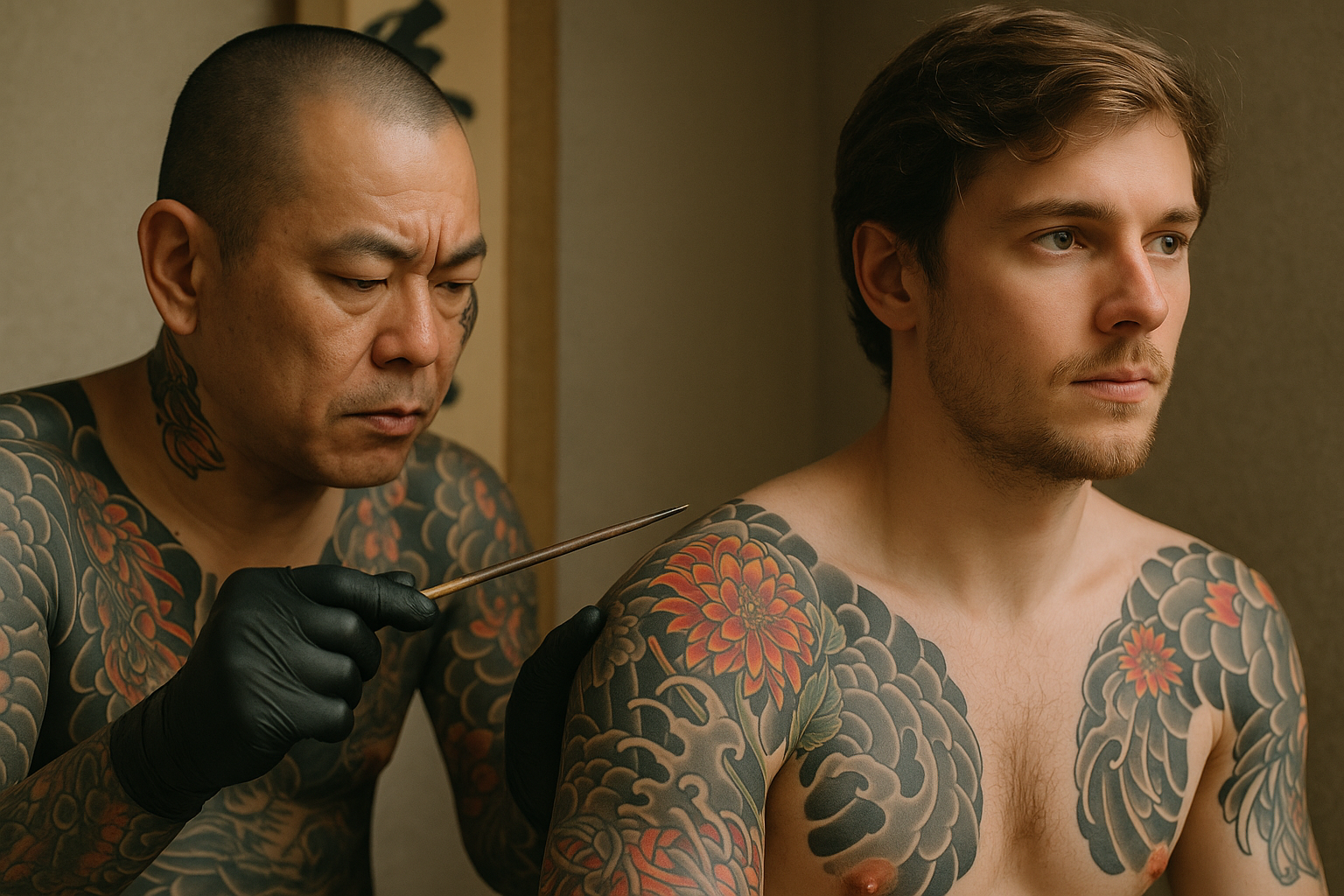In the age of Pinterest tattoos and machine-gunned flash sheets, Tebori — the traditional Japanese hand-poked tattooing method — stands out like a whispered vow in a room full of noise.
But as this sacred art gains global attention, so do the fakes. A growing number of “Tebori-inspired” tattoos are popping up in Western shops — done with machines, sold as exotic, but stripped of the depth, lineage, and flow that define true Wabori work.
So how do you separate the real from the rebranded?
Let’s break down the signs of a genuine Tebori artist — and how to avoid falling for a stylized imitation.
🪷 What is Tebori — Really?
Tebori (手彫り) literally means “hand carving.” It refers to the traditional Japanese tattooing method using soldered needles on a long wooden or metal rod, manually inserted into the skin by rhythmic hand pressure.
This isn’t just technique — it’s a ritual. Passed down through apprenticeships (Deshi) under a master (Horishi), Tebori tattoos embody a lineage, aesthetic discipline, and energy that machine work can’t imitate.
🎯 1. Ask About the Artist’s Lineage (Horimono Tradition)
A real Tebori artist studied under a Japanese master, often for years before even touching skin.
Questions to ask:
- “Who was your teacher or master?”
- “What was your apprenticeship like?”
- “Do you have permission to use a Horishi title (like Horifune, Horikazu, etc.)?”
🧠 Red Flag: If they say “self-taught” or name-drop YouTube as their Tebori mentor… walk.
🖼️ 2. Look at Full Body Flow — Not Just Isolated Images
Tebori tattoos are built for the human form, especially sleeves, backs, thighs. They follow natural lines of movement and muscle — a dragon wrapping from shoulder to wrist, a koi swimming along the calf.
Checklist:
- Are the designs built to wrap around joints and flow with the body?
- Are background elements like water, wind, or clouds used to connect motifs?
- Are the outlines smooth, bold, and continuous?
🔍 Knock-off Alert: Western “Tebori style” often focuses on bold motifs (e.g., a dragon or mask) slapped on with no background flow — more sticker than symphony.
🧰 3. Tool Check: Do They Actually Use Tebori Rods (Not Just Machines)?
Ask to see the tool. A traditional Tebori artist uses:
- A long handle (bamboo or metal)
- Soldered needle bundles (Hari)
- No buzzing machine — only the sound of cloth and breath
Some hybrid artists use a machine for outlines, then switch to Tebori for shading. That’s legit — as long as the hand technique is real.
⚠️ Red Flag: If you don’t see the rod, and they avoid showing their setup, it’s probably not Tebori.
🧼 4. Observe the Rhythm and Presence During Tattooing
True Tebori is a meditative rhythm — slow, steady, focused.
Watch for:
- Calm breathing and steady tapping motion
- The artist holding the skin with one hand while tapping with the other
- Silence or traditional music — not a tattoo studio party vibe
Real Tebori feels intimate, slow, and intentional.
🎭 Fake Alert: If they’re blasting music, multitasking, or chatting while poking — they’re likely simulating the aesthetic, not honoring the ritual.
📖 5. They Know the Meaning Behind Every Motif They Ink
A true Tebori artist won’t just tattoo a Hannya mask because it “looks cool.”
They will explain:
- What the Hannya symbolizes (jealousy, rage, repressed sorrow)
- Why it faces a certain direction
- What it’s paired with (lotus, flames, wind) to complete the meaning
🧠 Tebori artists are storytellers — each tattoo is a layered myth woven into the skin.
🙅♀️ Fake vibe: “Yeah, it’s just a dragon. It looks badass.” — if that’s all they say, you’re not in the right shop.
📍 6. They May Have a Japanese Name or Signature Style (But Not Always)
Many authentic Tebori artists are given a professional name starting with “Hori” (e.g., Horiyoshi III, Horikazu, Horifune).
But beware: some Westerners create fake “Hori” names to seem legit. That’s why lineage is more important than labels.
✅ Better signs of authenticity:
- Their style shows deep respect for spacing, background harmony, and figure motion
- They’ve studied Japanese art (ukiyo-e, sumi-e, etc.)
- Their floral work (e.g., peony, chrysanthemum) is layered and flows with other elements
📸 7. Portfolio Depth: Look for Full Sleeves, Backs, or Body Suits
True Tebori artists often specialize in:
- Full backpieces (Munewari)
- Arm sleeves with chest panels (Hikae)
- Thigh pieces or body suits (Wanzume)
Avoid artists who only show small patch tattoos without background flow or structure.
🔍 Zoom in on:
- Line clarity
- Shading softness
- Balance between negative space and saturation
💡 Final Tip: Authenticity Is Felt, Not Just Seen
A real Tebori artist respects the sacred exchange between body and ink. They don’t rush. They don’t imitate. And they’ll often turn clients away if the fit isn’t right.
Tebori isn’t about looking trendy — it’s about marking a transformation. A rite of passage in silence and flow.
🖤 Want to Wear the Spirit Without the Needles?
Not ready for the full Tebori commitment — but still want to channel the strength, sensuality, and sacred flow?
👉 Explore our Irezumi Tattoo Shirt Collection
Bold prints, feminine power, and stories written in thread — for women who wear survival like art.
📷 Image Suggestions:
- [Image 1]: A close-up of real Tebori rods (Hari) next to machine gear — side-by-side
- [Image 2]: Photo of a full Wabori sleeve in progress, showing flow and background
- [Image 3]: Artist mid-process using hand-poked technique (no machine)
- [Image 4]: Comparison between sticker-style tattoos and real Wabori with flow





Leave a comment
Your email address will not be published. Required fields are marked *